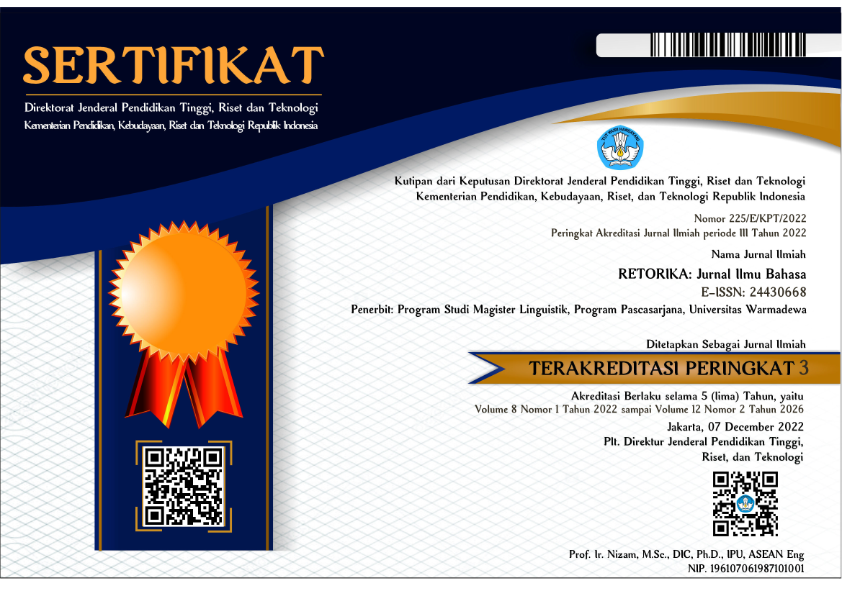“I can Speak Like You, I am Just Different†A Psycholinguistics Study of Autistic Child
Abstract
Language deficiency is one of the barriers that autistic children face in their language growth. Autistic children may face these difficulties in which they have trouble in understanding and communicating their language. Using Chaer's Language Disorders Theory (2003), this research attempts to investigate the receptive language disorders performed by an autistic child named Rahesa and the expressive language disorders performed by an autistic child named Rahesa based on Suherman’s (2016) theory. Using a qualitative with descriptive approach, the data were taken from the videos of the subject’s relationship with his mother, then transcribed into dialogs and analyzed. Then, researcher continued to describe all the findings. The findings of this research indicate that an autistic person has trouble interpreting the message of others and communicating his/her emotions by verbal words. An autistic boy has three difficulties with receptive language disorder, such as difficulty in interpreting verbal language, difficulty in following verbal guidance, and difficulty in focusing his mind.As far as expressive language disorder is concerned, an autistic person faces six difficulties, such as difficulty in inserting words into sentences, difficulty in choosing the correct expression, poor comprehension, taking words out of sentences, repeating some words or phrases, and inappropriately using language structure.The present thesis seeks to offer insights to prospective scholars who are interested in linguistic, in particular psycholinguistics concerned with language problems in the case of autism. General readers will enrich their understanding of and how to cope with the forms of language problems in autistic children.
References
Alwanchyad, H., Al-Zubaidi, A. S., & Frman, J. A. (2020). Verbal Language Disorders in Autistic Children. Indian Journal of Public Health Research & Development, 1798-1801.
Ary, D., Jacobs, Lucy Cheser Razavieh, A., & Sorensen, C. K. (2010). Introduction to research in education (8th ed.). Wadsworth Publishing.
Bhandari, S. (2019). Autism.
Chaer, A. (2003). Linguistik Umum. Jakarta: PT. Rineka Cipta.
Daulay, N. (2017). Struktur Otak dan Keberfungsiannya pada Anak dengan Gangguan Spektrum Autis: Kajian Neuropsikologi. Buletin Psikologi, 25(1).
Firmansyah, D. (2018). Analysis of Language Skills in Primary School Children (Study Development of Child Psychology of Language). Journal of Elementary Education, 2(1), 35–36.
Fish, S. (2011). How to Write A Sentence (1st ed.). New York: Harper Collins e-books.
Hall, D. (1988). Delayed Speech In Children: Usually Normal Variation But May Be A “Specific Speech And Language Disorder.†British Medical Journal, 297(6659), 1281–1282.
Hasanah. (2018). Kemampuan Berbahasa Anak Autistik Usia 6 Tahun. Qira’ah, 8(2).
Hikmawati, A., Djatmika, & Sumarlam. (2019). Expressive Skill of Children with Autism A Psycholinguistics Study. Humanus, 18(1), 101–113.
Jessy, M., & Diswantika, N. (2019). Efektivitas Terapi Applied Behavior Analysis (ABA) Terhadap Perkembangan Bahasa Anak Berkebutuhan Khusus Autisme. Cakrawala Pendas, 5(2), 105–109.
Kabir, S. M. (2016). Methods of Data Collection. Book Zone Publication.
Krippendor, K. (2004). Content Analysis: An Introduction to Its Methodology. SAGE.
Levia, R., Jufrizal, J., & Marlina, L. (2019). The Study of Language Disorder of an Autistic Savant Portrayed in Levinson’s Rain Man Film. E-Journal of English Language & Literature, 8(1).
Manipuspika, Y. S. (2019). Phonological Development of Children With Speech Delay. RETORIKA: Jurnal Ilmu Bahasa, 5(1), 12–22.
Murnianti, Sastra, G., & Marnita, R. (2015). Gangguan Berbahasa pada Anak Penderita “Attention Dificit Disorder/ADD†(Gangguan Pemusatan Perhatian) Studi Kasus Kepada Ichsan Muhammad Akbar. Arbitrer, 2(2), 184–195.
Nordquist, R. (2019). What Is Psycholinguistics?
Tiin, N. (2014). A study on Teachers’ Strategies in Teaching Reading Comprehension At the Second Grade Student’s MTs Tarbiyatul Ulum Panggungasri Panggungrejo Blitar Academic Year 2013/2014 [IAIN Tulungagung.
Priyatna, A. (2010). Amazing Autism!
Ratner, N., & Leason, J. (2004). Psychology.
Reilly, S., McKean, C., Morgan, A., & Wake, M. (2015). Identifying and Managing Common Childhood Language and Speech Impairments. BMJ: British Medical Journal, 350.
Rubenstein, J. L., & Merzenich, M. M. (2003). Model of Autism: Increased Ratio Of Excitation/ Inhibition In Key Neural Systems. Blackwell Munksgaard.
Sari, C. R., Suryana, D., & Pransiska, R. (2018). Keterlambatan Bicara Anak Usia 5 Tahun. Prosiding Seminar Dan Diskusi Nasional Pendidikan Dasar “Menyongsong Transformasi Pendidikan Abad 21.â€
Steinberg, D., & Sciarini, N. (2006). An Introduction to Psycholinguistics. Great Britain: Pearson Education Limited.
Suherman. (2016). Language disorder of Main Character in the Movie “My Name is Khan†[Universitas Islam Negeri Alauddin Makassar.
Trauner, D., Wulfeck, B., Tallal, P., & Hesselink, J. (2000). Neurological and MRI Profiles of Children with Developmental Language Impairment.
Watson, M. T. (2010). Qualitative Research Method. In Integrating Qualitative and Quantitative in Research (pp. 62-78). USA: University Press of America Inc.
Copyright (c) 2021 RETORIKA: Jurnal Ilmu Bahasa

This work is licensed under a Creative Commons Attribution-ShareAlike 4.0 International License.
This journal provides immediate open access to its content on the principle that making research freely available to the public supports a greater global exchange of knowledge.
All articles published Open Access will be immediately and permanently free for everyone to read and download. We are continuously working with our author communities to select the best choice of license options, currently being defined for this journal as follows: Creative Commons-Non Ceomercial-Attribution-ShareAlike (CC BY-NC-SA)
 Abstract viewed = 845 times
Abstract viewed = 845 times
 PDF downloaded = 1237 times
PDF downloaded = 1237 times

2.png)














